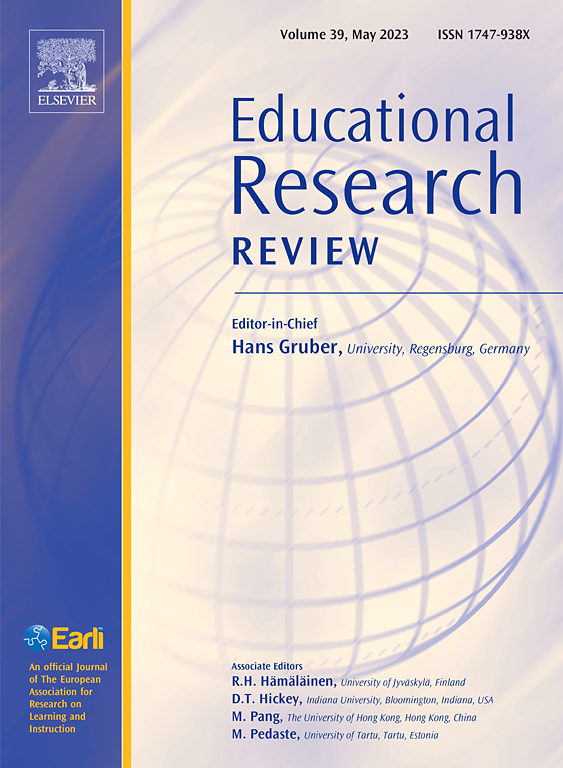The effects of physical activity interventions on prereading, early word recognition and spelling development in children: A systematic review and meta-analysis
IF 10.6
1区 教育学
Q1 EDUCATION & EDUCATIONAL RESEARCH
引用次数: 0
Abstract
Background
Reading and spelling skills are important abilities to acquire for later success in school and therefore it is highly relevant to examine strategies of facilitating these academic skills. Physical activity integrated with the learning sessions or physical activity added but not integrated with the learning sessions has been identified as possible strategies.
Objective
To identify, categorize and examine the characteristics and effects of interventions investigating the effect of physical activity on children's early reading skills.
Design
This systematic review follows the PRISMA guidelines. Studies were separated into two categories based on whether physical activity integrates academic content or not, i.e., 1) low integration interventions or 2) high integration interventions. Additionally, high integration interventions were further subgrouped based on the congruency of the activity (i.e., whether the movement supported the learning content). Low integration interventions were subgrouped based on the complexity of the activity (i.e., if the physical activity was cognitively/coordinatively demanding or not). Study quality was assessed, and effects were summarized narratively for each category. Furthermore, a meta-analysis was conducted to quantify both types of interventions. Only studies involving children with an intervention investigating the long-term effects of physical activity on prereading, word recognition, and spelling skills were included.
Data sources
PubMed, Web of Science, PsychINFO, Linguistics and Language Behavior Abstracts, ERIC and SportDiscuss.
Results
Twenty-three studies were identified and categorized into two groups (thirteen high integration interventions and ten low integration interventions). Across outcome measures, eight of the thirteen high-integration intervention studies reported statistically significant effects on at least one measure of prereading, word recognition, or spelling skills favoring the intervention. In contrast, only two out of ten studies categorized as low integration interventions reported a statistically significant effect. Multilevel meta-analysis showed an insignificant average random-effects model size of Hedges’ g = 0.03 (95% CI: 0.02, 0.09) for low integration and a significant effect size of g = 0.69 (95% CI: 0.12, 1.26) for high integration interventions. The distinction between low and high complexity within the low integration group, and between levels of congruency in high integration interventions, revealed no significant differences between these subgroups.
Conclusions
Results from the present review and meta-analysis suggest that the integration of physical activity into the classroom, using activities with a close temporal connection to the academic task (i.e., high integration interventions), appears to be an effective strategy to improve children's word recognition and spelling skills. Due to the limited number and heterogeneity across studies included these findings call for additional studies to clarify specific characteristics of the physical activity needed to support the process of learning to read and spell for children.
体育活动干预对儿童预阅读、早期单词识别和拼写发展的影响:系统回顾和荟萃分析
阅读和拼写技能是日后在学校取得成功的重要能力,因此研究促进这些学术技能的策略是高度相关的。与学习环节相结合的体育活动或增加但不与学习环节相结合的体育活动已被确定为可能的策略。
本文章由计算机程序翻译,如有差异,请以英文原文为准。
求助全文
约1分钟内获得全文
求助全文
来源期刊

Educational Research Review
EDUCATION & EDUCATIONAL RESEARCH-
CiteScore
19.40
自引率
0.90%
发文量
53
审稿时长
57 days
期刊介绍:
Educational Research Review is an international journal catering to researchers and diverse agencies keen on reviewing studies and theoretical papers in education at any level. The journal welcomes high-quality articles that address educational research problems through a review approach, encompassing thematic or methodological reviews and meta-analyses. With an inclusive scope, the journal does not limit itself to any specific age range and invites articles across various settings where learning and education take place, such as schools, corporate training, and both formal and informal educational environments.
 求助内容:
求助内容: 应助结果提醒方式:
应助结果提醒方式:


